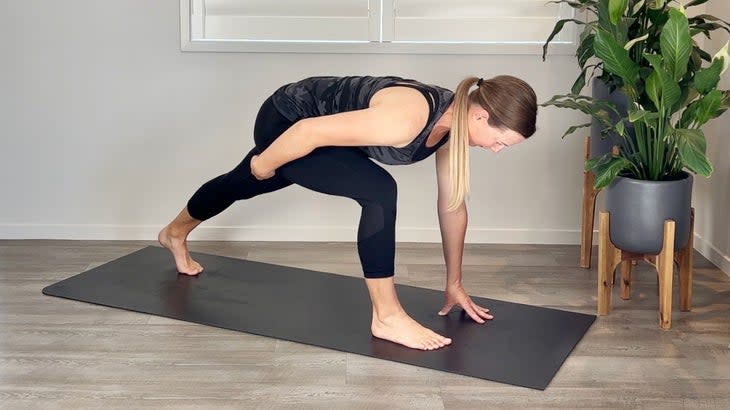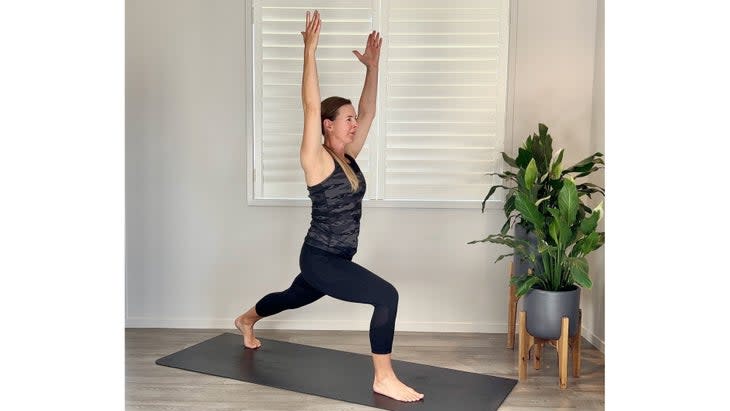This Is the Secret to Preventing Low Back Pain
This article originally appeared on Yoga Journal
Anyone who's experienced low back pain--and apparently that's most of us--will tell you that often the greatest discomfort comes when you move from one position to another. Imagine standing up from sitting or leaning over to pick something up, or in the context of a yoga class, moving between a lunge or forward fold to a standing position.
This shouldn’t be surprising. The low back is a key region of load transfer between the upper and lower body, especially during movement. The structures of the low back aren't delicate or fragile--in fact, over the course of our lives, they adapt to this load by becoming stronger and more resilient. But if we move inefficiently, there's still potential for the low back to work harder than necessary.
So how do we move efficiently, both in yoga and in daily life? We often hear about the importance of the abdominal muscles, and in particular the transversus abdominis in our deep core, which hug around the waist like a wide belt to create stability in this area. Something that's often overlooked, however, is the support we can garner from the lower body.
See also: The Best Stretches for When You’re Recovering From Low Back Pain
The power of your leg muscles
When you imagine an efficient transition for a lunge to a standing yoga pose, what area of the body comes to mind? You may first think of the low back, but if you fast-forward this movement, you'll recognize a sprinter's takeoff--and sprinters are most famous for their powerful glutes and legs.
Students of anatomy know that the gluteus maximus and the quadriceps are two of the largest muscles in the body, and are thus better equipped to do the "heavy lifting" in big movements than the smaller postural muscles that surround and support the low back. The gluteus maximus is our primary hip extensor, which means it should do the bulk of the work when we lift the torso from a lunge (i.e., moving out of hip flexion). In the reverse movement, it should also work eccentrically (contracting as it lengthens) to allow us to move back into hip flexion with control.
We can encourage our glutes to work by connecting more mindfully with our legs during yoga transitions. For example, when rising from a lunge or a forward fold like Uttanasana, imagine the floor is a trampoline. As you push down into your feet, you'll rebound up through the torso. This isn't pure imagination--our fascial matrix has the capacity for elastic energy storage.
Fascia forms our ligaments and tendons, and surrounds and penetrates most structures of the body, including the large muscles that make up our hips and legs. Often studied is the Achilles tendon at the back of the ankle: collagen fibers within the tendon stretch slightly as our foot impacts the ground, then rebound rapidly to release elastic energy, increasing power output beyond what our muscles could produce alone. You can imagine the role this plays in high-impact movements like jumping or sprinting, but it also conserves muscle energy in slower movements like walking or yoga.
But, that's not the only way the lower body aids efficiency in movement and supports the low back. Research has also uncovered strong fascial connections between the gluteus maximus on one side of the body and the opposite latissimus dorsi through the thoracolumbar fascia, creating a diagonal sling of support across the low back. Engaging this fascial chain, for example by firing the glutes, both stabilizes the low back and the hip, reducing energy expenditure from the muscles.
How your legs support your low back in yoga transitions
Of course, theory is no substitute for experience. The best way to appreciate the support strong legs provide for your low back is to feel it through movement. So let's explore the transition from Bird Dog to a Low Lunge and on to a High Lunge.
Come to all fours and gently draw in your waist. Without dropping your belly or tilting your hips, extend your right leg out behind you. Lift your foot off the floor and feel your right glute engage. Reach your left arm out in front of you, bicep by your ear, and subtly hug your left upper arm bone into its socket. Take a breath or two there, imagining a supportive connection between your left shoulder and right glute, running across your low back.
Lower your left hand, then curl your right knee toward your chest to step forward, using your hands or blocks to bring your right foot far enough forward that your ankle stacks under your knee.
Tuck your left toes and lift your left knee. Bring your right fingertips to your right sit bone to palpate the lowest fibers of glute max (like in the picture above), then without moving your right foot, energetically drag it back toward your left foot to feel your glute tone again.
Retaining that engagement, stamp down through your right foot as if on a slow-motion trampoline, to rebound your torso and arms up into a High Lunge.
Keep drawing in around your waist and firming the skin under your right sit bone as you slowly hinge forward to lower your hands back to the mat. Sweep your right leg back out behind you and your left arm out in front of you to return to bird dog, then repeat the sequence once or twice more on the same side to seal in the sensations before swapping sides.
Notice how the focus on your lower body, especially your front leg, allows you to tap into the power of your muscles, making the movement more efficient and reducing the workload for your low back.
While low back pain is one of the most common complaints of modern life, there's no need to view this region as vulnerable. The low back is beautifully adapted to negotiating a balance between mobility and stability, enabling it to transfer load between the upper and lower body in all the varied movements life involves. But it doesn't need to carry more than its fair share; recruiting support from the strong muscles and fascia of the legs can make transitions feel easier in both yoga and daily life.
For exclusive access to all of our fitness, gear, adventure, and travel stories, plus discounts on trips, events, and gear, sign up for Outside+ today.




